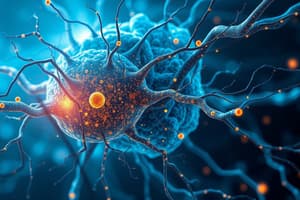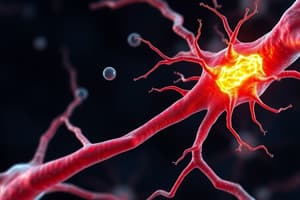Podcast
Questions and Answers
What triggers the opening of Ca2+ voltage-gated channels at the pre-synaptic ending?
What triggers the opening of Ca2+ voltage-gated channels at the pre-synaptic ending?
- Uptake into astrocytes
- Diffusion of neurotransmitter
- Binding of neurotransmitter to receptor
- Arrival of action potential (correct)
What causes vesicles containing neurotransmitter to fuse to the membrane at the pre-synaptic ending?
What causes vesicles containing neurotransmitter to fuse to the membrane at the pre-synaptic ending?
- Efflux of K+
- Influx of Ca2+ (correct)
- Breakdown of neurotransmitter
- Uptake into astrocytes
What happens when neurotransmitters bind to receptors on the post-synaptic membrane?
What happens when neurotransmitters bind to receptors on the post-synaptic membrane?
- Causes action potential to continue in post-synaptic nerve (correct)
- Causes uptake into astrocytes
- Causes breakdown of neurotransmitter
- Causes diffusion into surroundings
Which process involves the breakdown of neurotransmitters by releasing enzymes into the synaptic cleft?
Which process involves the breakdown of neurotransmitters by releasing enzymes into the synaptic cleft?
What determines the direction of the movement of ions during the reversal potentials in the endplate?
What determines the direction of the movement of ions during the reversal potentials in the endplate?
What is the role of EPSPs in regulating the post-synaptic potential?
What is the role of EPSPs in regulating the post-synaptic potential?
What is the function of IPSPs in generating the post-synaptic potential?
What is the function of IPSPs in generating the post-synaptic potential?
What is the knee jerk reflex made up of?
What is the knee jerk reflex made up of?
What is the role of astrocytes in the removal of neurotransmitters?
What is the role of astrocytes in the removal of neurotransmitters?
In the context of the reversal potential, what happens if the membrane potential is more positive?
In the context of the reversal potential, what happens if the membrane potential is more positive?
What determines whether a neurotransmitter is excitatory or inhibitory?
What determines whether a neurotransmitter is excitatory or inhibitory?
What is the function of EPSPs in generating the post-synaptic potential?
What is the function of EPSPs in generating the post-synaptic potential?
What is the primary effect of IPSPs?
What is the primary effect of IPSPs?
What is the knee jerk reflex made up of?
What is the knee jerk reflex made up of?
What causes vesicles containing neurotransmitter to fuse to the membrane at the pre-synaptic ending?
What causes vesicles containing neurotransmitter to fuse to the membrane at the pre-synaptic ending?
What are the 3 different types of removal of neurotransmitters?
What are the 3 different types of removal of neurotransmitters?
What is the primary effect of an IPSP?
What is the primary effect of an IPSP?
In the context of reversal potentials, what happens if the membrane potential is more positive?
In the context of reversal potentials, what happens if the membrane potential is more positive?
What triggers the opening of Ca2+ voltage-gated channels at the pre-synaptic ending?
What triggers the opening of Ca2+ voltage-gated channels at the pre-synaptic ending?
What determines whether a neurotransmitter is excitatory or inhibitory?
What determines whether a neurotransmitter is excitatory or inhibitory?
What is the function of EPSPs in generating the post-synaptic potential?
What is the function of EPSPs in generating the post-synaptic potential?
What is the role of astrocytes in the removal of neurotransmitters?
What is the role of astrocytes in the removal of neurotransmitters?
What causes vesicles containing neurotransmitter to fuse to the membrane at the pre-synaptic ending?
What causes vesicles containing neurotransmitter to fuse to the membrane at the pre-synaptic ending?
What is the knee jerk reflex made up of?
What is the knee jerk reflex made up of?
Flashcards are hidden until you start studying
Study Notes
Neurotransmission
- The opening of Ca2+ voltage-gated channels at the pre-synaptic ending is triggered by an action potential.
- Vesicles containing neurotransmitter fuse to the membrane at the pre-synaptic ending due to an increase in Ca2+ concentrations.
- When neurotransmitters bind to receptors on the post-synaptic membrane, they can either excite or inhibit the post-synaptic neuron.
Neurotransmitter Removal
- Neurotransmitters can be removed through three mechanisms: reuptake, enzymatic degradation, and diffusion.
- Astrocytes play a role in the removal of neurotransmitters from the synaptic cleft.
Post-Synaptic Potentials
- EPSPs (Excitatory Post-Synaptic Potentials) regulate the post-synaptic potential by making it more positive, increasing the likelihood of an action potential.
- IPSPs (Inhibitory Post-Synaptic Potentials) generate the post-synaptic potential by making it more negative, decreasing the likelihood of an action potential.
- The primary effect of EPSPs is to excite the post-synaptic neuron, while the primary effect of IPSPs is to inhibit it.
Reflexes
- The knee jerk reflex is made up of a sensory neuron, an integrating neuron, and a motor neuron.
Reversal Potentials
- If the membrane potential is more positive than the reversal potential, the direction of ion movement is reversed.
- The direction of ion movement during reversal potentials is determined by the membrane potential relative to the reversal potential.
- Whether a neurotransmitter is excitatory or inhibitory is determined by its effect on the post-synaptic potential.
Studying That Suits You
Use AI to generate personalized quizzes and flashcards to suit your learning preferences.




